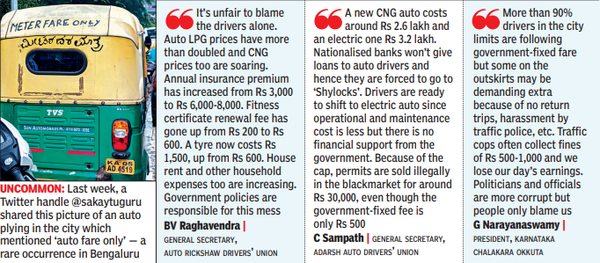Auto unions believe various government policies are to be blamed for this. They say the state government which was supposed to periodically revise auto fares did not do so between 2013 and 2021, despite a hike in auto LPG and other expenses. The revised rate (minimum fare for 2km: Rs 30 and then Rs 15 per km) came into effect only from December 1, 2021.

Bengaluru’s autorickshaws primarily run on LPG. For instance, auto LPG cost in the city has almost doubled in 31 months – from Rs 32.5 a litre in May 2020 to Rs 64 a litre in October 2022, an increase of Rs 31.5 per litre. Following rise in LPG prices, many shifted to CNG. But drivers say CNG prices too are soaring – Rs 50.5 per kg in April 2021 to Rs 85 per kg in October 2022, an increase of Rs 34.5 per kg.
Following the delay in fare revision, meters were sparingly used. They were virtually replaced by smartphones when app-based aggregators came into play in 2014-15. App-based aggregators measure the distance by using GPS over a mobile device instead of digital meters, saving passengers the trouble of haggling with drivers.
Initially, aggregators offered incentives for drivers. Regular users of autorickshaws gradually shifted to app-based aggregators. In fact, aggregators charged only a convenience fee of Rs 10 in addition to the meter fare. Later, some of them even offered a 4km auto ride at just Rs 29, but post pandemic, they increased the minimum fare to over Rs 100.
No incentives to shift to electric
While drivers are ready to switch to electric autos, the government is neither providing adequate subsidies nor setting up charging points at auto stands and other places. In 2011, the government provided a Rs 15,000 subsidy to convert two-stroke autorickshaws into four-stroke ones and the subsidy was later increased to Rs 30,000. Though drivers demanded that it be increased to Rs 50,000, the finance department rejected it. However, there are no such incentives for those shifting from four-stroke autos to electric versions.





